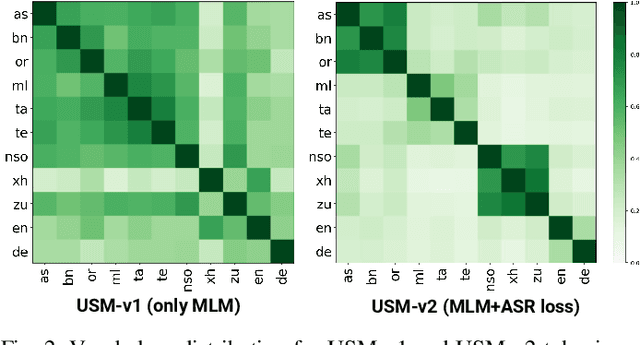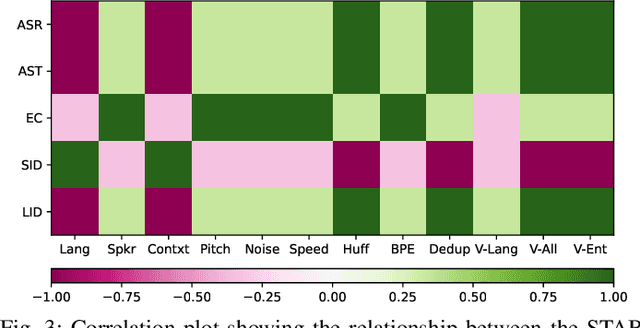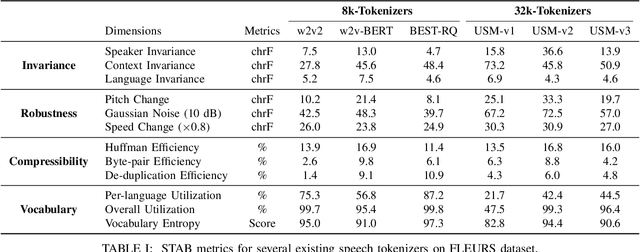Chulayuth Asawaroengchai
STAB: Speech Tokenizer Assessment Benchmark
Sep 04, 2024



Abstract:Representing speech as discrete tokens provides a framework for transforming speech into a format that closely resembles text, thus enabling the use of speech as an input to the widely successful large language models (LLMs). Currently, while several speech tokenizers have been proposed, there is ambiguity regarding the properties that are desired from a tokenizer for specific downstream tasks and its overall generalizability. Evaluating the performance of tokenizers across different downstream tasks is a computationally intensive effort that poses challenges for scalability. To circumvent this requirement, we present STAB (Speech Tokenizer Assessment Benchmark), a systematic evaluation framework designed to assess speech tokenizers comprehensively and shed light on their inherent characteristics. This framework provides a deeper understanding of the underlying mechanisms of speech tokenization, thereby offering a valuable resource for expediting the advancement of future tokenizer models and enabling comparative analysis using a standardized benchmark. We evaluate the STAB metrics and correlate this with downstream task performance across a range of speech tasks and tokenizer choices.
Gemini 1.5: Unlocking multimodal understanding across millions of tokens of context
Mar 08, 2024Abstract:In this report, we present the latest model of the Gemini family, Gemini 1.5 Pro, a highly compute-efficient multimodal mixture-of-experts model capable of recalling and reasoning over fine-grained information from millions of tokens of context, including multiple long documents and hours of video and audio. Gemini 1.5 Pro achieves near-perfect recall on long-context retrieval tasks across modalities, improves the state-of-the-art in long-document QA, long-video QA and long-context ASR, and matches or surpasses Gemini 1.0 Ultra's state-of-the-art performance across a broad set of benchmarks. Studying the limits of Gemini 1.5 Pro's long-context ability, we find continued improvement in next-token prediction and near-perfect retrieval (>99%) up to at least 10M tokens, a generational leap over existing models such as Claude 2.1 (200k) and GPT-4 Turbo (128k). Finally, we highlight surprising new capabilities of large language models at the frontier; when given a grammar manual for Kalamang, a language with fewer than 200 speakers worldwide, the model learns to translate English to Kalamang at a similar level to a person who learned from the same content.
AudioPaLM: A Large Language Model That Can Speak and Listen
Jun 22, 2023



Abstract:We introduce AudioPaLM, a large language model for speech understanding and generation. AudioPaLM fuses text-based and speech-based language models, PaLM-2 [Anil et al., 2023] and AudioLM [Borsos et al., 2022], into a unified multimodal architecture that can process and generate text and speech with applications including speech recognition and speech-to-speech translation. AudioPaLM inherits the capability to preserve paralinguistic information such as speaker identity and intonation from AudioLM and the linguistic knowledge present only in text large language models such as PaLM-2. We demonstrate that initializing AudioPaLM with the weights of a text-only large language model improves speech processing, successfully leveraging the larger quantity of text training data used in pretraining to assist with the speech tasks. The resulting model significantly outperforms existing systems for speech translation tasks and has the ability to perform zero-shot speech-to-text translation for many languages for which input/target language combinations were not seen in training. AudioPaLM also demonstrates features of audio language models, such as transferring a voice across languages based on a short spoken prompt. We release examples of our method at https://google-research.github.io/seanet/audiopalm/examples
Translatotron 3: Speech to Speech Translation with Monolingual Data
Jun 01, 2023Abstract:This paper presents Translatotron 3, a novel approach to train a direct speech-to-speech translation model from monolingual speech-text datasets only in a fully unsupervised manner. Translatotron 3 combines masked autoencoder, unsupervised embedding mapping, and back-translation to achieve this goal. Experimental results in speech-to-speech translation tasks between Spanish and English show that Translatotron 3 outperforms a baseline cascade system, reporting 18.14 BLEU points improvement on the synthesized Unpaired-Conversational dataset. In contrast to supervised approaches that necessitate real paired data, which is unavailable, or specialized modeling to replicate para-/non-linguistic information, Translatotron 3 showcases its capability to retain para-/non-linguistic such as pauses, speaking rates, and speaker identity. Audio samples can be found in our website http://google-research.github.io/lingvo-lab/translatotron3
 Add to Chrome
Add to Chrome Add to Firefox
Add to Firefox Add to Edge
Add to Edge